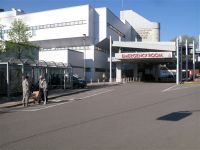LANDSTUHL, Germany, April 27, 2011 — The pace never slows at Landstuhl Regional Medical Center here, the largest U.S. military medical facility outside the United States and the first stop for wounded troops evacuated from the war zones.
More than 61,000 U.S. and coalition service members, civilian employees and contractors have been flown here since January 2004, public affairs officer Chuck Roberts reported. And with operations beginning to escalate in Afghanistan as spring sets in, the pace sees no sign of letting up.
About 12,700 of Landstuhl’s patients since 2004 have been battle-injured, about that same number have been able to return to duty “downrange” after treatment here, Roberts said. But for the vast majority of patients who arrive here, Landstuhl serves as a way point on the trip from the war zone to higher-level medical care in the United States.
This en route hub, where patients receive the most advanced “Level 4” medical care, is critical in the process of continually moving combat wounded to ever-increasing levels of care, Air Force Lt. Col. (Dr.) Raymond Fang, director of trauma care here, told reporters.
“Downrange, they have limited holding space, so they have to move people,” he said. “If they don’t move people quickly, they will quickly be overwhelmed.” Most combat casualties arrive here within three days of being wounded, Fang said, noting that Landstuhl has “the luxury of keeping people a little longer and being able to surge for a little bit longer.” The goal, he explained, is to stabilize patients until it is safe to move them to the United States or, in the case of coalition forces, their home country, for continued care.
“We try to ensure people don’t move from our facility until they are truly ready to be safely moved,” typically within about three days, Fang said. “We look at them, we make sure no injuries are missed, … [and] we keep them until we feel from our experience that it is safe for them to move onward.”
Experience is one of the most important qualities Landstuhl’s 3,000-member staff brings to the mission. Unlike in the combat theater, which experiences constant personnel turnover as medical staffs regularly deploy and redeploy, Landstuhl’s staff members typically serve at least three years.
“We take our role very seriously, acting as the corporate memory [and] corporate knowledge,” Fang said.
After seven years as trauma director here, Fang brings a nearly unprecedented level of expertise to the table as he oversees the care of the most seriously wounded incoming patients.
That’s critical at a time when Landstuhl is seeing some of the most severely wounded patients of the war, based on the Injury Severity Scale index used in civilian trauma centers. “In the past year or so, our average ISS score for our [intensive care unit] patients — who we really focus on, because they are the most significantly injured –- have been the highest in the war,” Fang said.
“These patients are young, they are fit and they have the best protection available right now, but their injuries are very severe,” he said.
Civilian trauma patients typically suffer from blunt trauma from a car or motorcycle accident or a penetrating trauma from a gunshot or stabbing, Fang explained. Combat wounded troops frequently suffer both, he added, as well as blast injuries.
“With these blast injuries, you get the blunt part of the concussive wave, you get the penetrating part of the fragment, you get the heat part with the burns,” he said. “You also get the blast component: the shock wave, the pressure wave of the blast itself. So we have four mechanisms in one. It’s our most common mechanism of injury here.”
Despite the severity of their wounds, Fang reported an amazing survivability rate among wounded warriors who arrive at Landstuhl. “You have a greater than 99 percent chance of survival if you can make it to us,” he said, citing 2010 statistics. “That is really unprecedented.” Most of the fewer than 1 percent who have died after arriving at Landstuhl suffered nonsurvivable injuries, but were brought to Germany to reunite with their families, he added.
Fang attributed the striking survival rate to a well-developed medical system that gets battlefield casualties medical treatment faster and closer to the point of injury than ever before and moves them to progressively more-advanced care facilities. That, he said, is an important factor.
“These patients, by our grading scales, are much more injured, and yet they are doing well,” Fang said.
Source:
U.S. Department of Defense
Office of the Assistant Secretary of Defense (Public Affairs)

 von
von 